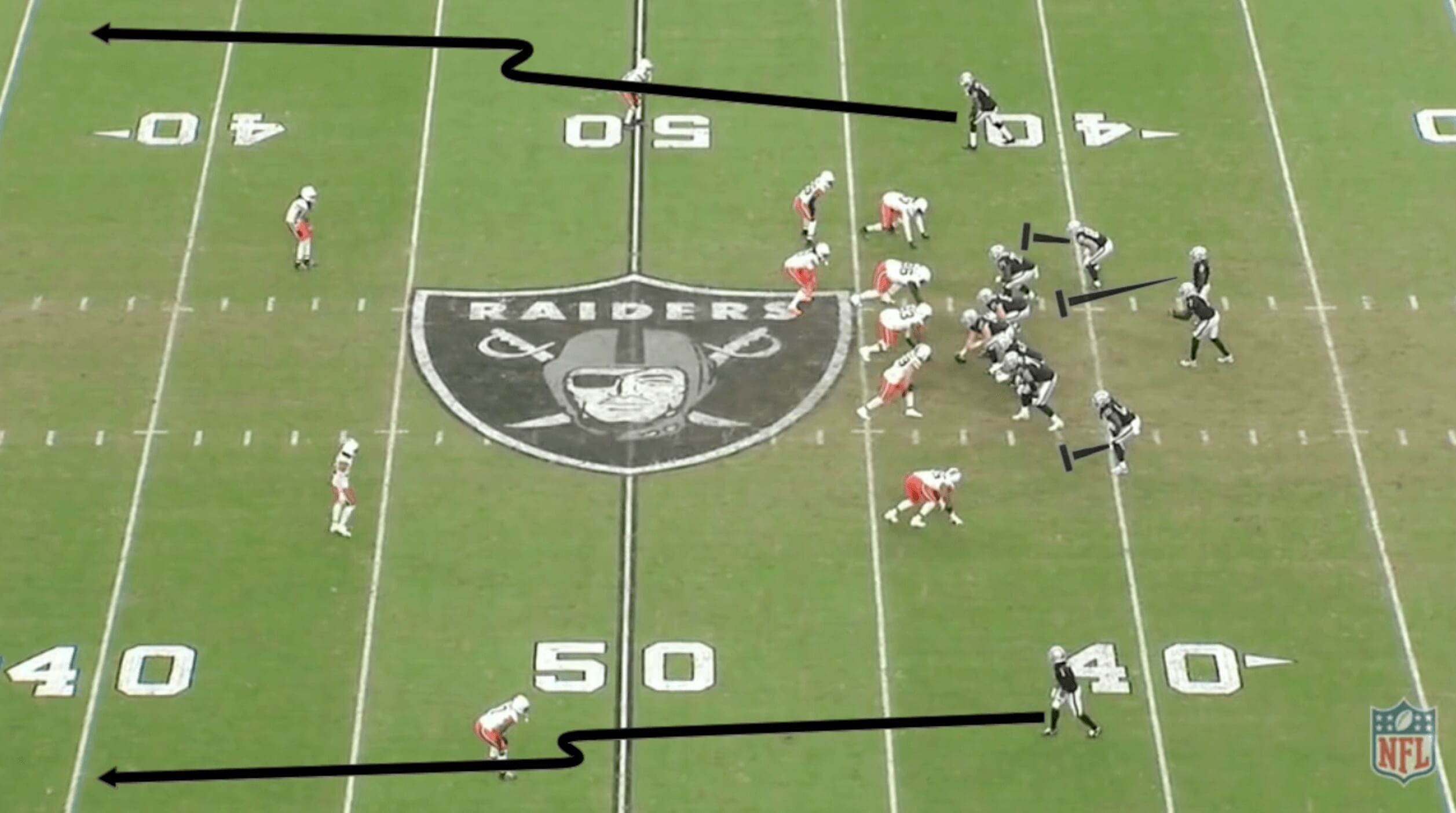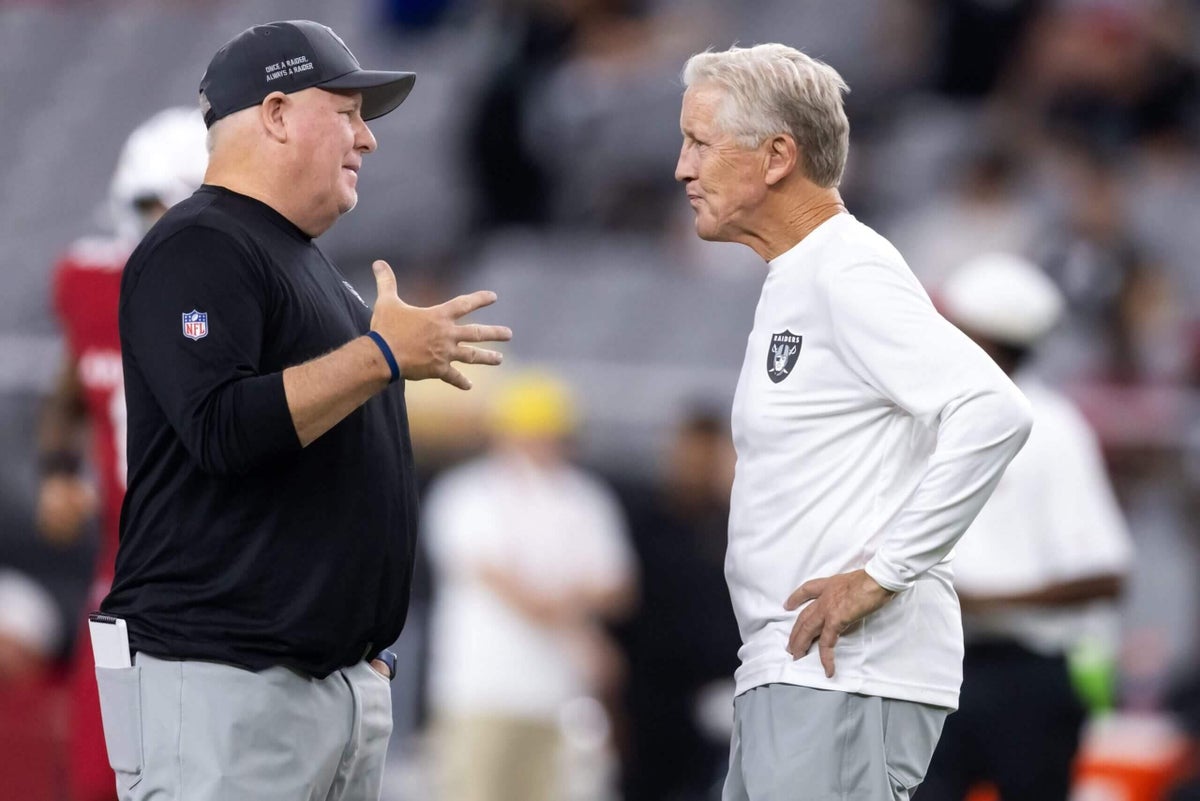The Las Vegas Raiders made Chip Kelly the highest-paid offensive coordinator in the league last offseason with a three-year deal at $6 million per year. It was a curious decision to pay a college offensive coordinator that much, even if he was coming off a national championship in the same position at Ohio State.
The Atheltic’s Michael Silver reported that the Raiders bid against themselves for Kelly. Now, they could be on the hook for the rest of his contract after firing him Sunday, just 12 weeks into the season.
The Kelly-Pete Carroll marriage seemed rocky from the start, with the head coach frequently criticizing play-calling in news conferences. Kelly was certainly limited by personnel — the Raiders’ offensive line that Sunday gave up 10 sacks to the Browns could be the league’s worst. However, Kelly’s system was poorly constructed, and many of the problems that have plagued former college-to-pro play callers were issues as well.
The Raiders’ pass concept menu was limited. This was apparent on third-and-long, when they would constantly run the same concepts, making them predictable. The Raiders don’t have a lot of talent at wide receiver, but it’s even harder to get open when defenders know where you’re running.
In Week 2, against the Chargers, quarterback Geno Smith was picked off on the first play. Safety Alohi Gilman broke on a seam pass and tipped the ball to a fellow defender. They had run the play successfully and repeatedly against the Patriots in Week 1. The Chargers clearly watched the film and were anticipating it.
The following week against the Bears, Smith was intercepted on third-and-long while trying to throw to the dig in a dagger concept. On the next third-and-long, Kelly called the same play, and Smith was intercepted again. College play callers don’t need a high volume of pass concepts to go to. You can’t get away with that in the NFL.
There has also been a clear lack of detail in the passing game. When a quarterback gets to the top of his drop, there should be a receiver looking back or getting ready to make his break. There were too many instances in which Smith would get to the top of his drop to find that there wasn’t a receiver getting ready to break or cut, causing him to hold the ball. The timing of the passing game was consistently off. This was apparent against the Browns.
4:49 remaining in the second quarter, third-and-15

On third-and-15, the Raiders kept eight men in to block and a two-man route concept (stutter-and-go’s on both sides of the field).

As Smith got to the top of his drop, neither receiver was close to looking back. Double moves don’t typically work on third-and-very-long because corners usually just sit deep, which is what happened on this play.

Even as Smith was getting hit, Tre Tucker still wasn’t looking back at the quarterback. There was space inside as the free safety was tilted to the other side of the field, but the called route was vertical and Tucker and Smith would have to ad-lib from the called play to take advantage of it.
Kelly never seemed to find balance with his play calling, and Carroll took note of it. After the Raiders’ overtime loss to the Jaguars, in which running back Ashton Jeanty only had 13 carries, Carroll said he wished the Raiders “got the ball to him on the perimeter a couple more times.” After the Raiders were blown out against the Cowboys, a game in which Jeanty only carried the ball six times for seven yards, Carroll said he influenced the game plan to heavily involve play-action passes.
“We were supposed to be ahead with that approach (play-action passing) then come back and run the football in the second half,” Carroll said. “I had influence on the game plan of being more pass/play-action heavy tonight. It’s on me.”
This was the first big red flag that Kelly should have been on alert. Carroll was starting to get more involved in the game planning. After the Browns game this week, Carroll took another jab at Kelly about taking shots.
“We were impatient with the throwing game … I wish we would have not taken those shots (downfield).”
Kelly had his shortcomings, but it’s hard to distinguish what part of the game plan was his and how much of it was influenced by Carroll. Two of Carroll’s sons remain on his Raiders staff, including Brennan Carroll, who plays a significant role as the offensive line coach and run game coordinator. Though Kelly was the highest-paid offensive coordinator in the league, he had to work with Carroll’s coaches and preferred players like Geno Smith, Tyler Lockett and Stone Forsthye.
The biggest issue has been the offensive line. Yes, there is a big talent-deficiency issue there, but the Raiders’ scheme didn’t offer players help. In fact, they’ve been put into more difficult situations because of the scheme. Kelly was supposed to be a run-game savant, but the Raiders’ running game has been one of the worst in the league. The Raiders lead the league in the rate of run plays that lead to negative yardage (17.81 percent). Jeanty is constantly getting hit in the backfield. The scheme is unsound. The most glaring example of this was in Week 3 when the Raiders had a chance to win the game with a field goal.
Week 3, 0:43 remaining in the fourth quarter, third-and-1

Down by one point, the Raiders were in fringe field goal range and had the chance to get closer with 43 seconds remaining in the game. On third-and-1, they ran a trap play, with which they were unsuccessful several times in the previous week against the Commanders. On this play, they didn’t have enough blockers on the play side to account for the inside linebacker.

The pulling tackle “trapped” the defensive tackle, but no one blocked the inside linebacker and Jeanty was tackled in the backfield. The Raiders attempted to kick a 54-yard field goal, but it was blocked and they lost.
The Raiders’ tackles, even after losing Kolton Miller, haven’t been given help by a running back or tight end on over 60 percent of pass plays. Kelly prefers to free release the running back and get five receivers into a route quickly, but you have to adjust to your personnel. The Raiders’ tackles need a lot of help.
Offensive tackle win rates when left on an island (and how often that happens) pic.twitter.com/09MDwtjI9N
— Timo Riske (@PFF_Moo) November 20, 2025
There were plays in which the defense’s best rushers were blocked by running backs or left totally unblocked. Whatever the reason for these constant mistakes, it’s unacceptable.
7:54 remaining in the second quarter, second-and-11

Here, the Raiders tried to run a play-action concept with the line sliding away from Browns All-Pro Myles Garrett. Usually, in this type of protection scheme, a running back or tight end would block the play-side end, which was Garrett on this play. Against really good pass rushers, some teams will have two players block the play-side end.

Instead, tight end Michael Mayer shoved Garrett for a second before running a route.

Garrett ended up unblocked and hit Smith as he was throwing the ball. Smith had Tucker open deep, but didn’t have the time to throw an accurate pass downfield.
The Raiders moved on from Kelly. Maybe he never had a shot to succeed with this franchise, but it was clear the NFL figured out his offense after his tenures with the Eagles and 49ers. Kelly’s failure very well could put an end to the pipeline of college play callers to the NFL. There are simply too many differences in how play callers on each level call the game. From different hash marks affecting the geometry of plays to protections to understanding how to tailor the scheme to personnel, play callers going from college to the NFL have to make a huge jump in complexity.

